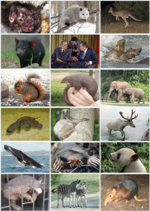 | Therapsida (redirect from Therapsids) A therapsid is a member of the clade Therapsida, which is a major group of eupelycosaurian synapsids that includes mammals and their ancestors and close... 28 KB (2,730 words) - 20:34, 25 April 2024 |
This list of therapsids is an attempt to create a comprehensive listing of all genera that have ever been included in the Therapsida excluding mammals... 89 KB (2,354 words) - 07:11, 25 October 2023 |
Ustia is an extinct genus of biarmosuchian therapsids from the Middle Permian of Russia. It is known from a single species, Ustia atra, which was described... 2 KB (156 words) - 02:48, 5 December 2021 |
"Hahnia" obliqua (redirect from Hahnia (therapsid)) "Hahnia" obliqua is a poorly known species of meat-eating stem-mammals (cynodonts) that lived during the Upper Triassic in Europe. It is based on tiny... 3 KB (300 words) - 20:04, 29 March 2024 |
 | (2021). "The evolution of the synapsid tusk: Insights from dicynodont therapsid tusk histology". Proceedings of the Royal Society B: Biological Sciences... 18 KB (2,089 words) - 08:10, 2 May 2024 |
Dinosaurus is an extinct genus of therapsid of controversial affinities. Its type and only species is Dinosaurus murchisonii. It is only known from a... 7 KB (707 words) - 07:34, 20 March 2024 |
(an arbitrary combination of letters) is an extinct genus of dicynodont therapsids from Russia. Four specimens have been found from the Sokolki Assemblage... 3 KB (247 words) - 16:17, 20 March 2024 |
 | more advanced therapsids became dominant during the Middle Permian. Mammals originated from cynodonts, an advanced group of therapsids, during the Late... 212 KB (22,683 words) - 14:21, 20 April 2024 |
 | Evolution of mammals (section Therapsids) (including monotremes), but not present in any of the early Triassic therapsids, is shown in Figure 1 (on the right), namely: mammals use two bones for... 141 KB (15,252 words) - 16:07, 26 April 2024 |
Dvina, a surface-to-air guided missile from the Soviet Union Dvinia, a therapsid reptile This disambiguation page lists articles associated with the title... 380 bytes (85 words) - 08:03, 23 April 2022 |
 | Eutheriodontia (category Therapsids) Eutheriodontia is a clade of therapsids which appear during the Middle Permian and which includes therocephalians and cynodonts, this latter group including... 4 KB (450 words) - 12:48, 16 November 2023 |
0.14 – 259.51 ± 0.21 mya. Therapsids became the dominant land animals in Guadalupian, displacing the pelycosaurs. Therapsids evolved from a group of pelycosaurs... 16 KB (1,576 words) - 05:51, 3 March 2024 |
 | Shaximiao Formation (section Therapsids) The Shaximiao Formation (simplified Chinese: 沙溪庙组; traditional Chinese: 沙溪廟組 / 沙溪廟層; pinyin: Shāxīmiào zǔ) is a Middle to Late Jurassic aged geological... 25 KB (1,201 words) - 22:43, 20 April 2024 |
theorize, theory ther- beast, animal Greek θήρ, θηρός (thḗr, thērós) therapsid, therianthropy, theroid, theropod, theropsid therap- serve Greek θεράπων... 2 KB (1,764 words) - 06:15, 16 April 2024 |
















